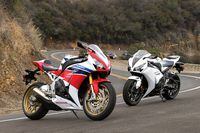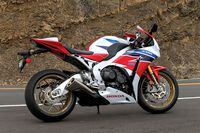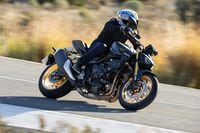Honda is on a roll lately, winning the MotoGP World Championship with its fire-breathing RC213V, tickling people's funny bones with the lovable Grom, and getting the industry percolating with fresh new models from CB500s to a Valkyrie reboot and a refreshed VFR800. Like many manufacturers, though, sportbikes seem to be a secondary priority for Honda in the current global economy. Many of the people who want them don't have enough money or credit to buy them, and the vast R&D; that goes into a modern supersport streetbike seems to really haunt the bean counters.
High-end performance machines still have their rightful place in any major manufacturer's lineup, and a company with Honda's racing pedigree won't be left behind. Enter Honda's new top-of-the-line superbike for the street: the CBR1000RR SP. If it looks like a standard CBR1000RR with Öhlins suspension, Brembo brakes, and Pirelli tires, that's because it is—with a few exceptions. We'll get to that in a minute.
Overshadowed by the introduction of the SP for 2014, the standard CBR1000RR nonetheless receives a handful of small updates. A freer-flowing airbox feeds intake and exhaust ports that have been widened in places and smoothed in others—Honda claims port performance matches World Superbike spec. The exhaust pipe has been reshaped, too, for better flow and more performance, Honda says. And lastly, a few minor ergonomic changes.
The SP model receives all of these upgrades plus a few more choice items. Most notable are the aforementioned Öhlins NIX30 fork and TTX36 shock suspending the SP, Brembo Monoblock front brake calipers doing the stopping, and sticky Pirelli Supercorsa SP tires putting it all to pavement. Aesthetically, the HRC tri-color paint is unique to the SP, as is the stylish seat cowl. The gilded wheels suggest fancy forging, but underneath they're the same cast rims the stock bike wears.
Keen eyes will spot a slightly different top triple clamp (incorporating a forged-steel steering stem, as opposed to aluminum) as well as holes cut in the subframe, presumably shaving weight and adding to the racy look. The result of all this effort? Three additional pounds, actually, which we can only assume come from the beefy Öhlins components tipping the scales more than the stock Showa pieces.
The last upgrade is actually significant and one that not even the sharpest eyes will spot. "Hand-selected" pistons and connecting rods are said to match perfectly and offer better balance in the engine, resulting in smoother running and more power. To find out how much more power (and how smooth), we tested the standard 2014 bike alongside the SP for two days: one at Buttonwillow Raceway and one on public roads to gauge street manners. Would the up-spec and limited-production SP make us want to throw rocks at the base model? We'd soon see.
Riding the standard bike reminded us of all the things we have always liked about the flagship CBR. Agile and predictable handling, prodigious midrange power, and a reasonably comfortable riding position are all notable real-world benefits of this potent yet civilized superbike. The engine changes are not immediately noticeable on the road (or on the track, for that matter), but some small ergonomic tweaks feel more substantial than you might expect. By slightly adjusting the angle and placement of the clip-ons, Honda has placed the rider's hands slightly farther apart, lower, and farther forward, meaning there is noticeably more weight on the rider's wrists for 2014. The footpegs, in turn, have been moved back 10mm, adding to the more aggressive rider stance.
Switching to the fancy SP model, then. Any differences were hard to detect at first, and only about half of the testers claimed they could feel the hand-picked engine internals running more smoothly. Definitely noticeable is the ride, which feels stiffer on the SP's Swedish springs. Twisty roads feel a little easier to navigate on the taut suspension, mostly because the stiffer shock keeps the steering geometry sharp and offers more feedback, especially when the suspension is under load.
Of course, more feedback on a mountain road translates to more "feedback" from bumps on freeways and city streets, but even with the track-ready Öhlins the SP is a perfectly agreeable sportbike on the street. The same ultra-smooth, ever-present midrange power, comfy seat, and flawless fueling that make us love the standard bike translates completely to the up-spec SP. Also contributing to handling are the tires. Road Test Editor Henning was quick to point out that the profile of the Pirelli Supercorsa SPs almost certainly contributes to agility on the street, with a pointier profile than the standard CBR's Dunlop Sportmax Qualifier rubber.
To ensure that both bikes were on equal footing for our time at the track, Supercorsa SPs were also fitted to the base CBR. Not surprisingly, it was on a racetrack that the SP shone brightest. The Öhlins components made the up-spec bike feel more planted, especially on initial turn-in and during quick transitions.
The SP isn't available with ABS in the States, so we opted for the non-ABS standard model for an apples-to-apples comparison. Sadly, the beautiful Brembo calipers fitted to the front of the SP didn't dazzle us. Only during extremely hard braking at the racetrack did the lever seem to offer slightly better feedback, but overall the brakes were totally comparable. European manufacturers often equip Brembo-shod bikes with braided steel lines, and to our eye Honda's decision to stick with standard rubber brake lines (as Japanese manufacturers typically do) surely sells the burly Brembos short.
At the end of the two days flogging the Honda at the track and running it over our favorite roads, we came to the conclusion that the paint and the suspension are the most notable differentiators between the bikes. But there's more to it than that. Draping a European superbike with Öhlins and Brembo is commonplace, but for a Japanese manufacturer to do so is unusual (though it certainly has been done before). And especially Honda, which is famously loyal to its in-house suspension and brake brands, Showa and Nissin, respectively. Some combination of motivations—pressure from the European distributor, perhaps, or world championship homologation—has driven Honda to this special production bike. Whatever the reason it is an intriguing departure.
Unfortunately, even with all of the changes and upgrades it's impossible to ignore the CBR's slide down the literbike pecking order. Fact is, 152 hp puts this superbike at the feet of 160 and 170 hp options from Germany and elsewhere in Japan. And while Honda's complicated (but effective) C-ABS system is a terrific option for the base model, the lack of traction control puts it behind all the European machines and half the Japanese liter-class supersports.
What Honda has created in the SP, then, is a better bike than the standard model. What buyers have to decide is whether or not it's $2,700 better. The cost of the upgraded suspension and brake components alone makes it seem like a no-brainer. In reality, though, the whole value discussion is probably moot; Honda's bringing in so few SPs, somewhere between 200 and 400, that it's almost assured you can't buy a new one if you tried.
Something else occurred to us when we weren't focusing on the name-brand hardware—there's an air of finality surrounding the SP, as though it's the swan song for the model. In many ways, the CBR1000RR SP is a shining example of what a high-end, analog superbike for the street should be—composed, smooth, easy to live with. But it's a digital world, and we can't help but look toward Honda's horizon.
Associate Editor
AGE: 29 | HEIGHT: 5'10" | WEIGHT: 171 lb. | INSEAM: 33 in.
I'm a fan of up-spec bikes. I like the idea of a base-model machine for those who are satisfied with the stock components and then a premium version for more discerning (or vain) riders. It's convenient to let the manufacturers suss out the setup and fitment, and there's typically some serious savings to be had (compared to upgrading a stock bike yourself).
Honda did a good job with the SP, though after riding the base bike and the SP back to back, the differences aren't as dramatic as, say, a Triumph Daytona 675 versus a 675R, or an Aprilia RSV4 R versus an RSV4 Factory. Part of the reason the bikes perform so similarly is that the stock bike is really good. The biggest difference is the tautness of the suspension and the quicker steering im-parted by Pirelli's excellent Supercorsa SPs.
To me, the CBR1000RR SP smells of a gambit to extend the appeal of this long-lived platform just a little while longer. I'm fine with Honda dragging its feet, as long as it means the next liter-bike is a street version of the RCV1000R production racer currently competing in MotoGP. A guy can dream.
Associate Editor
AGE: 30 | HEIGHT: 6'2" | WEIGHT: 185 lb. | INSEAM: 34 in.
To me, this fancy SP model using cheap rubber brake lines with lavish Brembo calipers is an admission that Honda sees the bike as little more than a museum piece. To be fair, I think it's beautiful; the HRC paint scheme (stickers, actually) is really sharp, and those bright gold Swedish suspenders add bling to any bike. But then, if it's going in a museum, what's it paying tribute to?
What this test reminded me of most (other than how much I like Pirelli Supercorsas) is what a wonderfully refined bike the basic CBR1000RR is, and the extra $2,700 for this SP edition is a good deal considering the upgrades you get. However, the problem with weighing this SP's func-tionality is what $16,700 gets you elsewhere in the sportbike market. Apart from Öhlins suspen-sion, the options from Aprilia, BMW, and Kawasaki are all better equipped, more powerful, and cheaper. Give us the RCV1000R streetbike we've been waiting for, Honda, and remind the compe-tition who they're messing with!
SP power and torque feels as smooth from the saddle as it looks on the graph, with lots of midrange grunt to play with. Sadly, the numbers are barely just big enough to be competitive these days.
The CBR still offers one of the most comfortable riding positions of any sportbike, but it's more aggressive for 2014 than previous years.
Honda drapes its flagship CBR with Öhlins suspension, Brembo brakes, and Pirelli Supercorsa tires.
Aprilia RSV4 R, BMW S1000RR, Ducati 1199 Panigale, Kawasaki ZX-10R, KTM RC8 R, Suzuki GSX-R1000, Yamaha YZF-R1
Still a fine superbike, still lacking the electronic rider aids that would make it more competitive in its class.

















/cloudfront-us-east-1.images.arcpublishing.com/octane/2WF3SCE3NFBQXLDNJM7KMXA45E.jpg)
/cloudfront-us-east-1.images.arcpublishing.com/octane/G4MG6OUCJNBSHIS2MVVOTPX65E.jpg)
/cloudfront-us-east-1.images.arcpublishing.com/octane/IIGGWFOTOJGB7DB6DGBXCCMTDY.jpg)
/cloudfront-us-east-1.images.arcpublishing.com/octane/QSTCM6AVEZA5JJBUXNIQ3DSOF4.jpg)
/cloudfront-us-east-1.images.arcpublishing.com/octane/U4I7G625B5DMLF2DVIJDFZVV6M.jpg)
/cloudfront-us-east-1.images.arcpublishing.com/octane/B6XD6LS6IVCQPIU6HXDJSM3FHY.jpg)
/cloudfront-us-east-1.images.arcpublishing.com/octane/ICL63FEDDRDTTMINYICCEYGMDA.jpg)
/cloudfront-us-east-1.images.arcpublishing.com/octane/FCGZHQXRBZFLBAPC5SDIQLVF4I.jpg)
/cloudfront-us-east-1.images.arcpublishing.com/octane/WNOB6LDOIFFHJKPSVIWDYUGOPM.jpg)

/cloudfront-us-east-1.images.arcpublishing.com/octane/X33NU3E525ECRHXLNUJN2FTRKI.jpg)
/cloudfront-us-east-1.images.arcpublishing.com/octane/6KKT5NNL2JAVBOXMZYS5ZO76YA.jpg)
/cloudfront-us-east-1.images.arcpublishing.com/octane/J5RKG5O455GMPGQRF2OG6LRT7A.jpg)
/cloudfront-us-east-1.images.arcpublishing.com/octane/GX2CIZKQVRH2TATDM26KFG2DAE.jpg)
/cloudfront-us-east-1.images.arcpublishing.com/octane/ZWIDYSAKQZHD5BHREMQILXJCGM.jpg)
/cloudfront-us-east-1.images.arcpublishing.com/octane/CYUHJZCTSJCH3MRAQEIKXK7SCQ.jpg)
/cloudfront-us-east-1.images.arcpublishing.com/octane/LKOFINY56FCXJCANJ5M7ZDQUBY.jpg)
/cloudfront-us-east-1.images.arcpublishing.com/octane/4NBPDACMWJH63JQYJVK3QRBDZI.jpg)
/cloudfront-us-east-1.images.arcpublishing.com/octane/KKHQHRR3FJGX7H2IPU6RALMWG4.jpg)

/cloudfront-us-east-1.images.arcpublishing.com/octane/5IOFS5JAE5FOXMNA23ZRAVVYUU.jpg)
/cloudfront-us-east-1.images.arcpublishing.com/octane/CGXQ3O2VVJF7PGTYR3QICTLDLM.jpg)

/cloudfront-us-east-1.images.arcpublishing.com/octane/OQVCJOABCFC5NBEF2KIGRCV3XA.jpg)